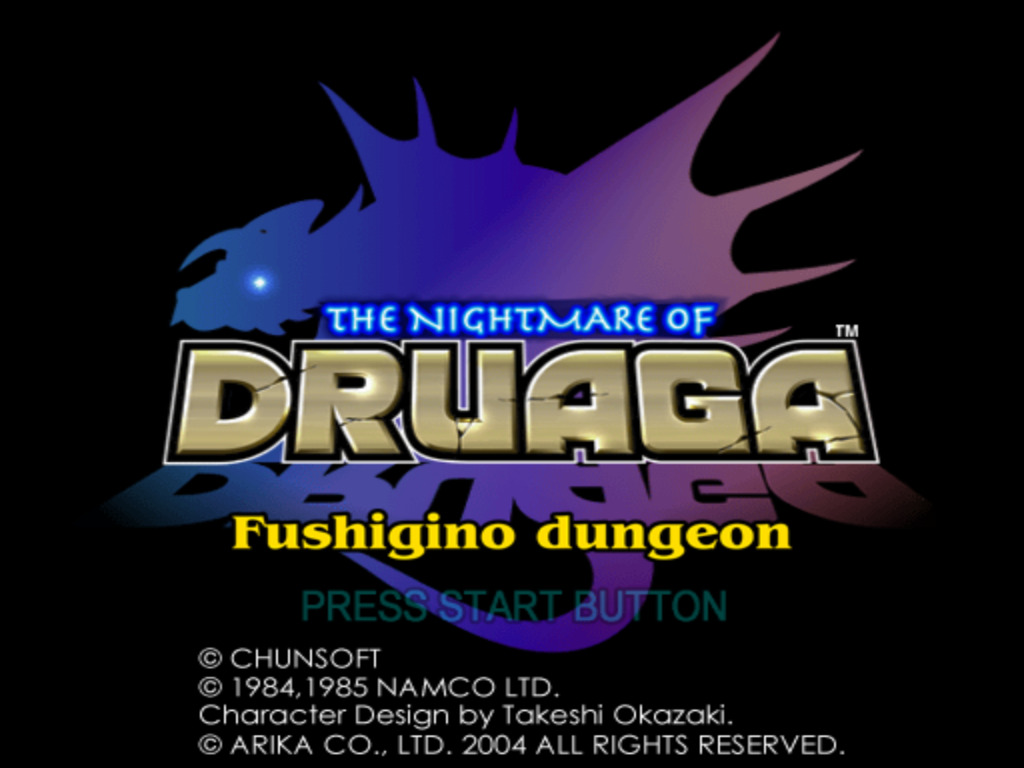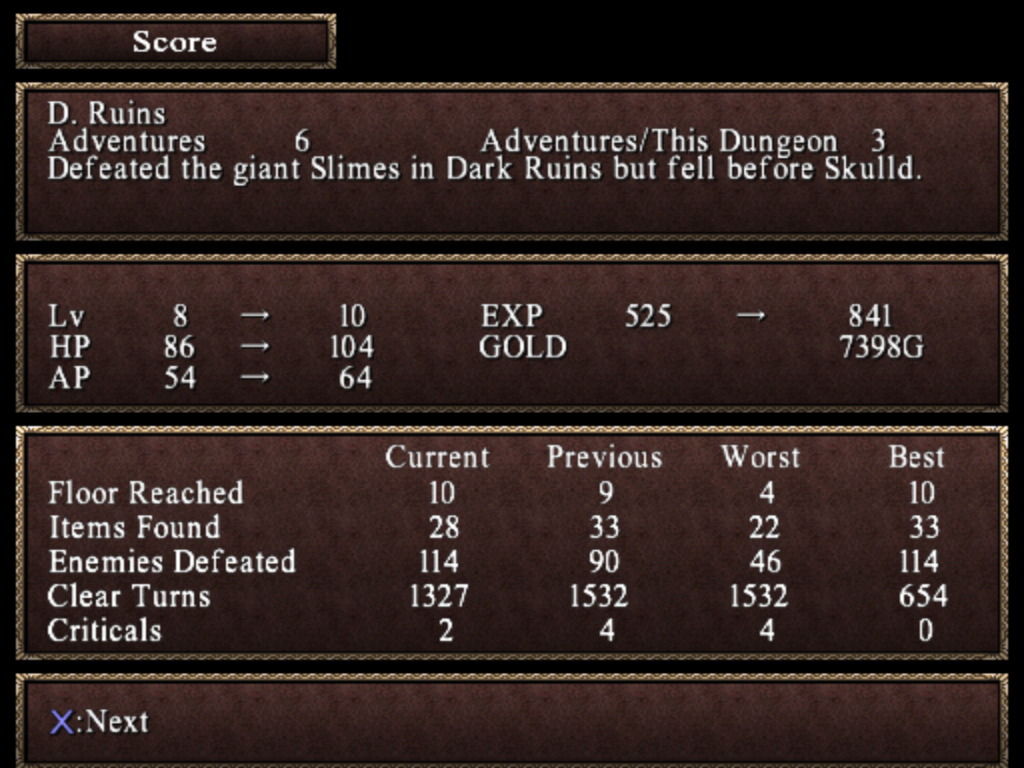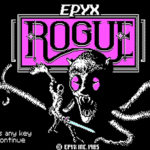In the beginning, there was the game “Rogue”. Fifty levels of dungeon, each randomly generated, and you didn’t know what anything you picked up did, exactly, without rolling the dice and quaffing, reading, wielding, eating or equipping it. Monsters moved when you moved; if you didn’t move, nothing else happened. Over time, you would grow hungry and weary. Time and the environment were as much dangerous as the monsters.
The Mystery Dungeon (Fushigi no Dungeon) series was a long running console adaptation of Rogue, with main characters a little more memorable than Rogue’s iconic “@”, and usually some sort of plot involved that was more than grab an artifact from the lowest level and return it to the surface.
The Babylonian Castle Saga was a long running series of dungeon crawlers, starting with a couple of arcade games and running in various forms through the years, eventually spawning an MMO and a mobile game. It was said to be the inspiration for such famous dungeon crawlers as The Legend of Zelda and Ys. They tell the story of warrior Gil (Gilgamesh) and priestess of Ishtar, Ki, who fight the demon Druaga by ascending his sixty level tower. The first version ran on Pac Man arcade hardware. Common elements include not only the characters, but Gil’s golden armor, keys to continue to the next level, secret chests that appear when you do some very specific action, a mysterious Blue Crystal Rod, and iconic monsters types.
In the Nightmare of Druaga (Fushigi no Dungeon), these two game series collide.
The game opens three years after the defeat of Druaga in the previous game, on the day Ki and Gil are to be wed. The sorceress Skulld appears just before the vows, encases Ki in crystal, and spirits her away to the sealed dungeon that lies beneath the town. Only Gil can rescue her, and on this journey that eventually includes three dungeons and the original sixty level Tower of Druaga, Gil will find out the true story behind Ki, Skulld, Druaga, and the Blue Crystal Rod.
This is my first “Druaga” game, so I can’t really talk about how good an entry into that series this is, but “Chocobo Mystery Dungeon” was my absolutely go to smash hit from a couple of years back, and I got a fair way through “Shiren the Wanderer” before the punishing difficulty finally had me tapping out, so I’ve had a pretty good time with the Mystery Dungeon games.
In my first few hours of play, I thought that this was the best game ever. As the hours dragged on, I realized just how grindy a game could be.
Normal weapons and armor drop frequently in the dungeon, but this gear is almost useless. The best gear comes from finding Silver and Gold chests. Finding a Silver chest requires you to do something very specific; the game does not tell you what to do, and it is different in every level. In order to find a Gold chest, you must run through the dungeon to that level again, and do something even more specific (like, stand in front of every torch in the dungeon, or, kill these three mobs in this specific order without killing anything between). The only way you would know how to get these things was to get the hint book — and have a good working knowledge of Japanese. (Or, for us non-Japanese understanders, GameFaqs has an excellent guide).
Weapons and armor are upgraded by fusing trash normal gear to them at the blacksmith’s. After raising it to +15, you can then have another NPC merge the special moves attached to a weapon to another weapon. Building your perfect weapon is going to take a lot of dungeon crawling… and then when you come across a better weapon, this all happens again.
You have your standard health bar, but you also have the ability bar and your protection meter. Abilities are attached to weapons, and give you the tools to take on the more powerful enemies with more powerful attacks, area attacks, uncounterable attacks and so on. While health slowly regenerates over time, ability points only refresh via potions.
Protection is the blessing of the goddess Ishtar. She grants you a certain amount of protection when you enter a dungeon, that manifests as a light from your armor that illuminates the area. As you move, the protection diminishes, until at zero protection, you are moving in complete darkness. You can sacrifice items to her to increase her protection back to the maximum, but then that means fewer items to help in the dungeon or back in town.
The town doesn’t sell weapons or armor, as that would make the necessary leveling of gear to +15 too easy. It does offer a selection of potions and spikes — throwing weapons that are the only method of dealing with certain enemies. The town also offers quests, which are instanced dungeons where you start off with a specific set of gear and abilities and have a certain task to complete in order to receive the reward.
Available in the dungeons are “bonus” dungeons, which are randomly generated, high difficulty levels that open up once you have left a floor using a key. Upon your return and subsequent leaving again, you are given the option to instead continue into a bonus dungeon. There is no using a Feather to escape a bonus dungeon. You win or die.
Dying incurs a hefty penalty. You drop everything you were carrying at the place of your death, and half your gold is deleted. Ishtar provides you with a new set of starter gear, but you’re on your own in getting back to your corpse.
The game is oddly compelling. It is grindy as heck, because you do not want to overextend yourself. The word “roguelike” is almost meaningless today. The original Rogue never actually expected you to finish the main objective; playing the game itself was the fun. And if you did win, grats, go do it again!
By pairing Rogue up with an actual story, there’s a pressure to work through the grind and actually win the game to see the ending. And the story — which plays out as cutscenes from time to time — is interesting enough to me to work through.
The game is sadistic, but then, I am a little bit masochistic, so it works for me. For you? I don’t know. This game was reviewed poorly when it came out; I imagine later games in the series are a little friendlier to new players, just as Chocobo Mystery Dungeon was when I played it.
This was an unexpected find at the State Line retro games store in Enfield, and I’m glad I grabbed it. I hope to finish it.









The degradation of the meaning of the term Roguelike really annoys me, because I absolutely love old school asci graphics roguelikes (Moria, Angband, Zangband, Mangband and Sangband all have their charms, never liked Nethack as much for some reason). I also enjoy editing the text files that manage the drop tables to customize my game.
Back when Diablo first came out, pretty much any Roguelike was going to be a dungeon crawler with randomized loot where you focus on building up one character. That kind of game is nearly always worth at least taking for a spin to see if I dig it. Now the term is so overused and expanded that that it gives me no information at all about whether I might enjoy a game. In fact a lot of them I actively dislike.
On topic, that looks up my alley. I have Diablo for the PS1, and that’s actually my favorite way to play it. I also have some pretty obscure Roguelikes on the PS1 and PS2. I used to have the PS2 Everquest game based on Baldur’s Gate: Dark alliance, but I traded it in at some point because it slightly bit. However, I now really wish I hadn’t. Sucky or no, I would like it for my collection, and it’s gotten pretty expensive and hard to find.
There’s this YouTuber we watch named Splattercat, and Kasul and I just wait, every video, for him to describe a game — ANY game, ANY genre — as a roguelike. I think he defines it as simply having a GAME OVER screen.
Nightmare of Druaga definitely is as roguelike as you can expect a console game with arcade roots to be, but I feel it doesn’t have the permanency that you get in actual roguelikes, in that you can recover after defeat (with a penalty). That said, I very much enjoyed the tongue-lashing you get from the in-game goddess Ishtar if she thinks you smashed the reset button on your PS2 to reload a previous save. I did that by accident, and I had to go through screen and screen of promises that I would never, ever, try to save scum, ever again 🙂
I used to save scum all the time with the old school roguelikes. You can try to stop me but I will not be stopped ><